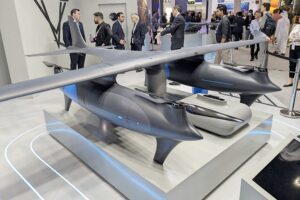If you weren’t already hyped for Palm Springs Drone Fest & Expo happening this month from March 21-23, new details on where to stay just took this event to the next level. We now know exactly where the VIP speakers, performers and sponsors will be staying. And trust me — it’s not just a hotel, it’s a full-on desert retreat that will make this event feel even more exclusive. I can’t wait to see the FPV footage coming out of the resort grounds.
Palm Springs Drone Fest 2025: what to know
Palm Springs Drone Fest is a first-of-its-kind celebration of all things drones. Running from March 21 to 23, 2025 at Palm Springs High School in California, it’s set to be the ultimate drone fan event. Registration is already open, but new details around where the hotel (and afterparty) is make this even more compelling.
First off, we have a list of the speaker lineup, which consists of top industry leaders including La’Quata Sumter, Ph.D of Steam Thru Drones, drone pilot and safety expert Desiree Ekstein, agricultural photographer Fiona Lake, Promo Drone CEO Jamar Williams, Women and Drones founder (and children’s book author) Sharon Rossmark and even me, Sally French!
Also expect to get to meet VIP guests including Moon Hee Suh of FIDA International and China’s April Wei.
The Palm Springs Drone Fest hotel: Acres Landing Airstream Resort & Hotel

Acres Landing Airstream Resort & Hotel (Desert Hot Springs) stands as the official Palm Springs Drone Fest hotel. This VIP hotspot isn’t your typical event lodging — it’s a luxury Airstream resort with hot mineral spring pools, epic desert vibes and a level of exclusivity that’s unmatched. This is where the who’s who of the drone industry will be staying, making it the place to network, unwind and maybe even sneak into the invite-only afterparty.
Rumor alert: There’s an invite-only VIP afterparty happening here…and if there is, I may or may not be there.
If you’re looking for a nearby stay, check out Aqua Soleil Hotel, another great option just minutes away from the action.
Why Palm Springs Drone Fest is a game-changer

Looking for a way to meet other drone pilots in person? There hasn’t been a ton in the way of large-scale meetups. Many of the larger conferences like Interdrone in Vegas have called it quits. COVID-19 also put a damper on much of the momentum around in-person events.
But finally, the Palm Springs Drone Fest offers something this industry has desperately needed.
Sure, there are conferences focused almost entirely on the business side. There are targeted events for industries like DFR or law. But what about a huge celebration around the pure joy of drones? Palm Springs Drone Fest is it.
This will bring together hundreds of people who love all facets of drones to Palm Springs High School.I expect it to be the best (and most fun) drone event of 2025. Palm Springs is located in southern California’s Sonoran Desert and is famous for its resorts (and also for hosting the famous Coachella Valley Music and Arts Festival). With this, maybe it’ll become famous for its drone festival, too.
Palm Springs Drone Fest highlights
Here are some other highlights to expect:
- Live Demos & Hands-On Experiences: Get up close with the latest drone tech and watch the pros in action.
- Special Performance by Esther Anaya: International violinist Esther Anaya will bring her electrifying performance to the festival, blending music and drone artistry like never before.
- Stunt Actor Fiona Dorn: Because drones aren’t just for filming action—they ARE the action!
- Incredible Drone Light Show: As the sun sets over Palm Springs, prepare to be mesmerized by a jaw-dropping drone performance. If you’ve never seen a drone light show before, know that this will redefine your perception of aerial entertainment.
- Drone Film Festival: Enter (or just watch) cinematic drone footage.
- Drone Soccer World Cup Qualifiers: Witness (or compete in) fast-paced drone soccer matches. And yes, you can fly with the Korean Drone Soccer National Team or train to be a drone soccer official.
- Breakout Sessions: Learn from industry experts about drone business opportunities, film production, and even drone-based search and rescue.
The ultimate drone festival experience
As it stands today, large-scale drone festivals like this are rare. While there are scattered drone meetups, competitions, and educational conferences across the country, few offer the comprehensive experience of Palm Springs Drone Fest. Whether you’re into high-adrenaline drone sports, cinematic aerial photography, or simply networking with fellow drone lovers, this event is set to be a must-attend destination for the drone community.
Register now for Palm Springs Drone Fest
It’s the first-ever Palm Springs Drone Fest. That means yes, you need to be there.
As far as tickets? They’re already flying fast. With no-risk refunds up to 7 days before (aside from fees), grab yours now before they sell out.
A one-day pass is just $33.85 (includes festival entry, breakout sessions, trade show access, free parking, and more). But let’s be real—you’re going to want the three-day all-access pass to catch every light show, tournament, and demo.
Oh, and rumor has it I’ll be there too. So if you want to meet up, this is the event to make it happen. Whether you’re coming to compete, connect, or just have your mind blown, Palm Springs Drone Fest is THE event of 2025. See you in the desert!
The post Palm Springs Drone Fest hotel, speaker details emerge appeared first on The Drone Girl.











